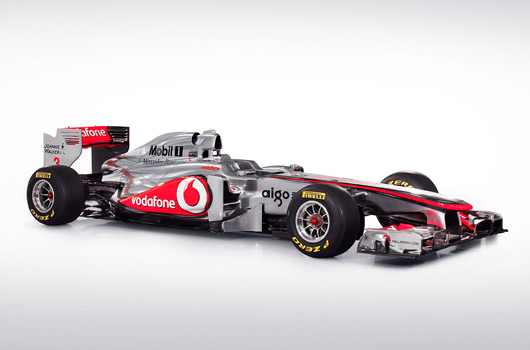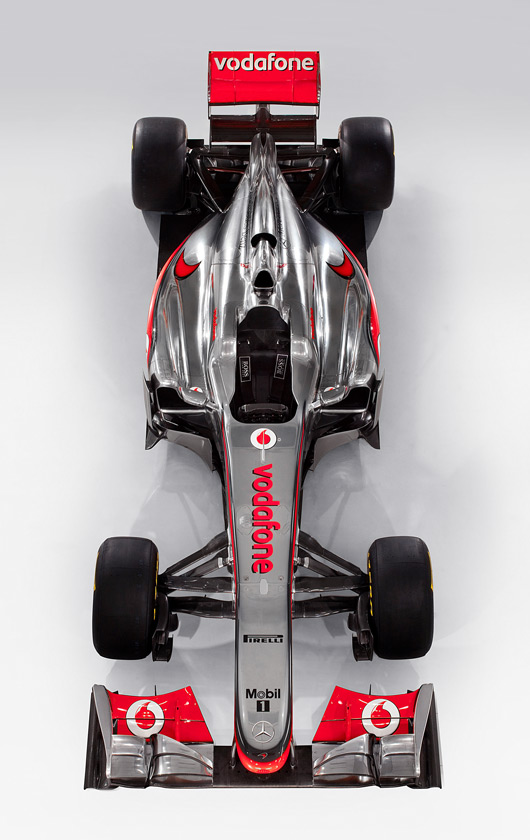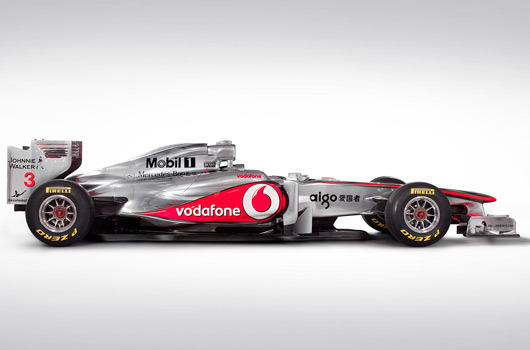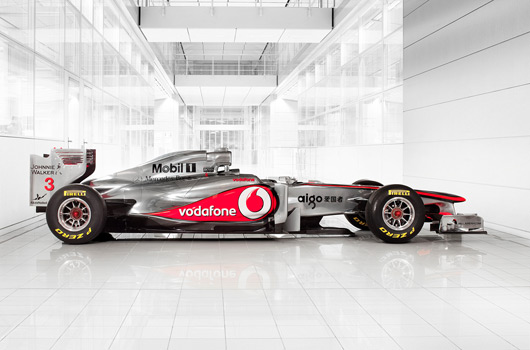McLaren chose the Potsdamer Platz in central Berlin as the location for their reveal of the MP4-26. The team used the first test at Valencia earlier this week to focus on gathering tyre data and the real test for the 2011 will begin in earnest at Jerez next week.
More studio pics are available below including selected material from McLaren’s press releases.
Of note is the comment on the design of the MP4-26 from Tim Goss, Director or Engineering, “I think there are some novel features on the car—the long wheelbase and U-shaped sidepods are probably the most obvious examples.
“The thinking behind that is to feed as much good-quality air as possible to the rear-lower mainplane and the floor of the car. We want to get the rear-end working as well as possible following the loss of performance caused by the banning of the double-diffuser.”
[Source: McLaren]
UPDATE 6 February: HERE is an interesting take on McLaren’s launch from Peter Windsor.
McLaren MP4-26 tech spec
Chassis
- Monocoque: McLaren-moulded carbonfibre composite incorporating front and side impact structures.
- Front suspension: Inboard torsion bar/damper system operated by pushrod and bell crank with a double wishbone arrangement.
- Rear suspension: Inboard torsion bar/damper system operated by pullrod and bell crank with a double wishbone arrangement.
- Electronics: McLaren Electronic Systems. Including chassis control, engine control, data acquisition, dashboard, alternator, sensors, data analysis and telemetry.
- Bodywork: Carbon-fibre composite. Separate engine cover, sidepods and floor. Structural nose with intergral front wing Driver-operated drag reduction system [active rear wing].
- Tyres: Pirelli P Zero
- Radio: Kenwood
- Race wheels: Enkei
- Brake callipers: Akebono
- Master cylinders: Akebono
- Batteries: GS Yuasa Corporation
- Steering: McLaren power-assisted
- Instruments: McLaren Electronic Systems
- Paint solutions: AkzoNobel Car Refinishes using Sikkens Products
Engine
- Type: Mercedes-Benz FO 108Y
- Capacity: 2.4 litres
- Cylinders: 8
- Maximum rpm: 18,000
- Bank angle: 90°
- Piston bore maximum: 98mm
- Number of valves: 32
- Fuel: ExxonMobil High Performance Unleaded (5.75% bio fuel)
- Spark plugs: NGK racing spark plugs specially designed for Mercedes-Benz F1 engine
- Lubricants: Mobil 1 – combining greater performance, protection and cooling with increased economy and lower emissions
- Weight: 95kg (minimum FIA regulation weight)
KERS [hybrid]
- Type: Mercedes-Benz
- e-Motor: Engine-mounted electrical motor/generator
- ESS: Integrated energy storage cells and power electronics
- Power: 60 kW
Transmission
- Gearbox: McLaren-moulded carbon-fibre composite. Integral rear impact structure.
- Gears: Seven forward and one reverse.
- Gear selection: McLaren seamless shift, hand-operated
- Clutch: Carbon/carbon, hand-operated
- Lubricants: Mobil
Vodafone McLaren Mercedes brings Formula 1 to the people with unique MP4-26 car reveal in the centre of Berlin
In a unique event attended by hundreds of fans, Vodafone McLaren Mercedes this morning brought together members of the public to construct and reveal its new MP4-26 chassis, the team’s challenger for the 2011 FIA Formula 1 World Championship.
Revealed at Berlin’s Potsdamer Platz, the famous public space that sits on the fringe of the old Berlin Wall, the car was built up by dozens of Vodafone competition-winners, fans and customers carrying components into the arena, where the new chassis was gradually pieced together in front of a huge crowd.
This culminated in our race drivers – 2008 world champion Lewis Hamilton and 2009 world champion Jenson Button – assembling the very final pieces to reveal the completed racecar.
Looking radically different from last year’s race-winning chassis, MP4-26 features a range of aerodynamic features designed to take advantage of new rules significantly limiting the amount of downforce that can be derived from the car’s underbody.
These most notably include distinctive U-shaped sidepods – to feed air more efficiently to the car’s rear-end – and a drag reduction system [active rear-wing], introduced for 2011 to increase the potential for overtaking.
Beneath the skin, the car houses an all-new electric KERS [hybrid] system. Vodafone McLaren Mercedes, along with our engine partners Mercedes-Benz HighPerformanceEngines, became the first-ever Formula 1 team to win a grand prix using a hybrid device in 2009, and this new system is expected to further refine that race-winning package.
The team continues for 2011 with the proven driver pairing of world champions Lewis Hamilton and Jenson Button. Between them, they helped Vodafone McLaren Mercedes to five grands prix victories, three one-two results and second overall in the 2010 constructors’ championship.
Following today’s launch, Vodafone McLaren Mercedes’ Gary Paffett will shake down MP4-26 during a private session at the Idiada Proving Ground in Spain on Tuesday February 8 before the team begins track testing at the Circuito de Jerez on Thursday February 10.
Q&A with technical director Paddy Lowe and director of engineering Tim Goss
What are the significant visual changes to the MP4-26?
Tim: “I think there are some novel features on the car – the long wheelbase and U-shaped sidepods are probably the most obvious examples. The thinking behind that is to feed as much good-quality air as possible to the rear-lower mainplane and the floor of the car. We want to get the rear-end working as well as possible following the loss of performance caused by the banning of the double-diffuser.
“For 2011, KERS [hybrid] is now a single integrated unit that sits within the survival cell, beneath the fuel-tank. In 2009, it was housed in the sidepods. The hybrid’s cooling intake sits directly below the main rollhoop intake.
“And, once again, we’ve really pushed the car’s cooling configuration: we’ve got a second air intake on the engine cover for gearbox and hydraulic cooling.â€
What have been your biggest challenges ahead of the 2011 season?
Tim: “For me, there have been two: recovering the rear downforce we lost following the banning of the double-diffuser, and fully exploiting the Pirelli tyres. The tyres only last for around 10 laps, and making them last longer is quite a challenge. So we need to look closely at how we configure the set-up and suspension to make the tyres last.â€
Paddy: “Getting KERS [hybrid] back on the car was a big task. Collaborating with Mercedes GP to define the specification for Mercedes-Benz HighPerformanceEngines was very satisfying: there was great collaboration and co-operation between us. There can be lots of difficulties finding alignment between two teams, but I’m pleased with how we made it happen and very happy with the outcome.â€
Tim: “The system was also more difficult to package because you’ve got to carry more fuel. That was the first challenge, but we got through that. There were a few difficult decisions concerning architecture around different aerodynamic concepts, but I think we ended up with a design layout we’re happy with.â€
You’ve both stressed the team-effort that has characterised the development of this car – does the recent restructure of the technical management reflect that?
Paddy: “The restructure reflects Tim’s increased role within the engineering department, but it’s also been good to delegate the work around the next generation of senior engineers coming through in the company.
“For MP4-26, we’ve distributed the workload around five or six senior engineers in different specialist areas – and that’s a structure that will continue under Tim’s watch. I’m really proud of the depth of talent that we can draw upon at McLaren Racing, and there have been some great opportunities for some new players to contribute directly to the car at a high level.
Tim: “And it’s not just good for them; it’s good for the company and good for the end-product. I think we’re going to make better cars because we have wider access to the horsepower available within the design system. They’re all good guys and all have good ideas – it’s a cliché, but car design really is a team effort these days.â€
What are your immediate aspirations as you roll out MP4-26?
Tim: We set ourselves a very ambitious aerodynamic target for 2011. We always want to do more and we’re always very critical about performance, but we feel we’ve done a good job. We’ve identified some areas where we can add performance to the car – over the next weeks, the task will be to get them on to the car and reliable by the first race. That’s the big challenge.â€




5 replies on “McLaren unveils 2011 F1 car”
[…] Vodafone McLaren Mercedes (MP4-26) 3. Lewis Hamilton (GB) 4. Jenson Button (GB) […]
[…] the presser below states McLaren will be using an MP4-26, which is their latest 2011 spec machine. Surely not? Usually F1 teams keep a few old chassis […]
[…] has just posted an overview of its 2011 Formula One steering wheel found on the MP4-26. Just what do all those buttons […]
[…] It’s understood the sidepods will be quite similar to last year’s McLaren MP4-26. […]
[…] The official launch of the 2012 McLaren MP4-27 Formula One car as just taken place at the team’s headquarters in Woking, Surrey. The car you see here has been described as an evolution on last year’s MP4-26. […]